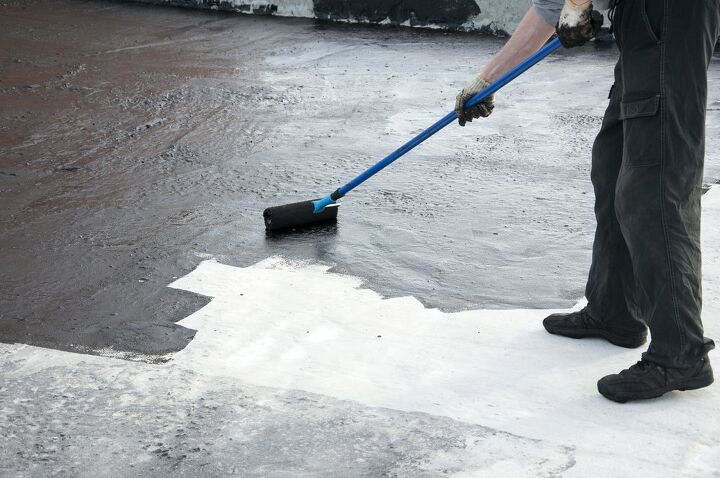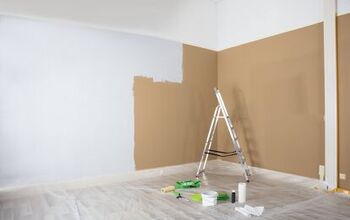Can You Paint Over Sealed Concrete? (Find Out Now!)

You may have a desire to brighten up the drab appearance of your sealed concrete walls and floors. These surfaces are often hidden by carpet, wall art, and other surface coverings. You can also paint sealed concrete to liven up any room as long as you have patience and the correct materials.
Inspect the sealed concrete in order to see if you need to strip a top coat or add additional moisture-resistant sealant. Fill holes and cracks before sanding the entire surface. Clean and dry the sealed concrete before adding a first layer of primer. Once the primer is dry you can apply the first and second coats of epoxy or acrylic latex concrete paint.
Sealed concrete is not always the simplest type of surface to paint. There are several potential factors that can affect the steps you must take for a quality result. However, by performing tests and inspections you can determine the correct steps needed to successfully paint your sealed concrete surface.
Don't want to do it yourself?
Get free, zero-commitment quotes from pro contractors near you.

Inspect the Concrete
The first step in painting a sealed concrete floor is inspecting the surface. It is crucial you determine what type of sealant or top coat is on the concrete, and if the concrete is in pristine or damaged condition.
Some concrete sealants repel more than others. If your concrete has an acrylic or epoxy sealant, it may resist paint just as it would rain. Other sealants like water-based sealants allow for more breathing. Determine the nature of the sealant to determine how much sanding you will need to do.
Remove Excess Sealant and Stains
You may notice deep stains or thick sealant on your concrete surface. Certain concrete sealants, like acrylic concrete sealants, may show as an impenetrable layer over the concrete. This helps a great deal with water resistance, but will inhibit paint from sticking for long.
If you have an acrylic sealant, paint, or other large stains that may inhibit painting, you must remove them before moving forward with the paint job. Scraping and sanding works best for lasting smooth results.
Note: For thick layers of sealant, you may need to strip and sand off an entire layer of sealant before painting to ensure lasting results.
Do A Moisture Test
If your concrete surface is sealed it should also be water-resistant. Still, it is wise to perform a moisture test to confirm the concrete is ready for the next steps.
- Cut one square foot of plastic (plastic wrap works well).
- Use strong tape to securely adhere it to the concrete surface you wish to test. Make sure no air can get in along the edges.
- Wait 24 hours.
- Inspect the plastic enclosed square. If you see any moisture collected in the taped area you should look into a better sealant for the concrete before painting. If there is no moisture in the plastic area then you are ready to move forward with painting preparation.
Fill Holes and Cracks
Before you paint sealed concrete be sure the entire surface is smooth with even surfaces. Use a concrete filler to patch any holes and to smooth over any cracks that may have developed in the concrete.
Allow ample time for the concrete filler to dry completely. Any extra filler can be scraped and sanded in the next step.
Sand Surfaces
Sanding sealed concrete helps create a level canvas for painting and also helps yield lasting results. Be sure to pay particular attention to areas you patched or filled with concrete filler to ensure they are smooth and level.
When you sand and clean a concrete surface it gives it a bit of grit and texture. This texture helps primer and paint stick to the concrete surface. This is crucial when painting sealed concrete as paint often does not naturally cling to the surface of sealed concrete. A quality sanding job before priming the sealed concrete can significantly increase the longevity of your paint job.
Clean the Surface
Once the floor is properly filled, sanded, and swept it is ready for a thorough cleaning. Warm water and degreaser is the best solution to use when preparing a sealed concrete surface for cleaning.
Use a scrub brush to work the degreasing cleaner throughout the surface. Allow the surface time to thoroughly dry before moving on to the next step.
Safety Tip: Be sure to allow plenty of ventilation when using a strong cleaner on the surface. This prevents chemical inhalation and also helps the surfaces dry.
Prime The Surfaces
Priming is an important step in many painting projects, and when you paint sealed concrete it is absolutely essential. If you paint a concrete surface without priming it first there will likely be significant peeling over time and inferior overall results. Be sure to choose the right primer for your job.
Concrete primer is also known as block primer, and there are a variety of types you can choose from. Choose the right primer based on what type of finished product you are trying to achieve (indoor, outdoor, walls or floor all make a difference).
Choosing the Right Paint
There are two main types of paint used to paint concrete. The two paints are acrylic latex concrete paint and epoxy concrete paint. Both are highly effective when painting sealed concrete surfaces, but the two different styles will result in varying final products.
Acrylic Latex Concrete Paint
Acrylic concrete paint is commonly used on interior and exterior walls. Applying acrylic concrete paint is similar to applying most acrylic paint. The process is fairly straightforward and does not involve any mixing or multi-step processes like epoxy paint. Using acrylic paint is also cheaper, so it is a good go-to for a simpler project that you are not looking to show off.
Acrylic paint is not as durable as epoxy paint, so it is not the best choice for frequently washed surfaces or floors in busy spaces. This type of paint, however, does help protect against UV damage and helps to conceal cracks and other surface imperfections.
Epoxy Concrete Paint
Epoxy concrete paint is a slightly more advanced and highly effective type of paint used to paint sealed concrete floors. It is highly durable, which means it can be cleaned frequently without chipping. This type of paint is also longer lasting in general over acrylic paint. These reasons make it the common choice for those painting a concrete floor.
Epoxy paint is also significantly more weather resistant than acrylic concrete paint. It will be the best option for concrete that is often exposed to extreme weather.
An epoxy paint leaves a glossier finish as well. If you are looking for a stylish sleek look with a shine to it, epoxy paint is most likely what you should choose.
Epoxy paint does require a two-step process, which involves a resin and a hardener. This may be a bit intimidating for a novice painter, but if you follow the instructions correctly, the results and process will be the same. If you have any questions on how to mix epoxy paint, be sure to ask a professional before beginning the process.
Apply Paint To Concrete
When you paint concrete, it is best to start by using the brush method for detailed borders, and then rolling the remainder.
- Brush the perimeters. When you paint a sealed concrete surface, first start by painting a careful layer of paint on the perimeters. This allows for a more detailed stroke along the more delicate areas.
- Roll the interior areas. Once the borders are brushed, you can use a roller to paint the interior areas. This is not only a time saver but it also provides a more even coat of paint.
- Start with the area farthest from the exit. When you are painting a floor be sure not to paint yourself into a corner. Concrete paint will take hours to dry, so be sure you start with the area furthest from the exit.
Don't want to do it yourself?
Get free, zero-commitment quotes from pro contractors near you.

Related Questions
How Does Staining Concrete Differ from Painting it?
Stain and paint have very different effects on concrete. Stain absorbs into the concrete. It must be done before the concrete is sealed, and should be sealed after it is stained to ensure lasting results.
Stain does not conceal the look of concrete. It is a translucent finish that changes the looks of the concrete without completely masking it like paint does.
Is Painted Concrete Slippery when wet?
Many concrete paints tend to become very slippery when wet. Concrete paints go on smooth and are water-resistant. This can be dangerous when you use this paint to cover a sealed concrete floor.
There are additives that can add grit and texture to your paint. This allows for traction and can help prevent slip hazards on your floors. Be sure to speak with a paint specialist at your hardware store to find the correct level of additive for your painting project.
Does Weather Matter When Painting Concrete?
When you paint concrete be sure you do not paint when it is too cold or too hot and humid. Before painting it is always important to check your paint can to see the proper conditions to paint.
Some paints will not set properly if it is too cold (often below freezing conditions). Hot and humid temperatures can also affect your results when painting sealed concrete.

Tom Gaffey is an expert writer who currently resides in Washington D.C. Tom has a passion for real estate and home improvement writing, as well as travel and lifestyle writing. He lived the last twelve years in Hawaii where he worked closely with luxury resorts and event planners, mastering his knowledge of aesthetics and luxury products. This is where he found his passion for home improvement and a keen interest in DIY projects. Currently, Tom resides in Washington D.C, and also working on his debut fiction novel.
More by Tom Gaffey



























